engine RENAULT TWINGO 2009 2.G Electrical Equipment - Petrol Injection Workshop Manual
[x] Cancel search | Manufacturer: RENAULT, Model Year: 2009, Model line: TWINGO, Model: RENAULT TWINGO 2009 2.GPages: 348
Page 142 of 348
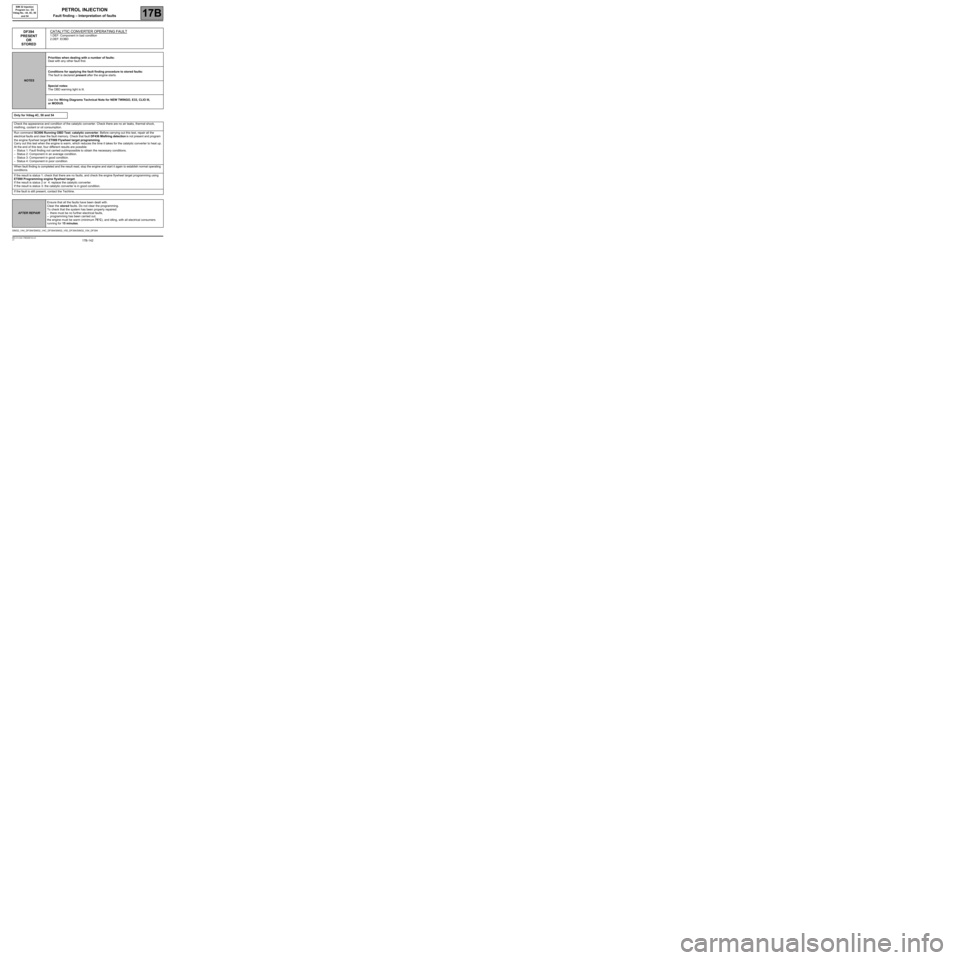
17B-142V7 MR-413-X44-17B000$133.mif
PETROL INJECTION
Fault finding – Interpretation of faults17B
SIM 32 Injection
Program no.: D3
Vdiag No.: 44, 4C, 50
and 54
DF394
PRESENT
OR
STOREDCATALYTIC CONVERTER OPERATING FAULT
1.DEF: Component in bad condition
2.DEF: EOBD
NOTESPriorities when dealing with a number of faults:
Deal with any other fault first.
Conditions for applying the fault finding procedure to stored faults:
The fault is declared present after the engine starts.
Special notes:
The OBD warning light is lit.
Use the Wiring Diagrams Technical Note for NEW TWINGO, E33, CLIO III,
or MODUS.
Only for Vdiag 4C, 50 and 54
Check the appearance and condition of the catalytic converter. Check there are no air leaks, thermal shock,
misfiring, coolant or oil consumption.
Run command SC006 Running OBD Test: catalytic converter. Before carrying out this test, repair all the
electrical faults and clear the fault memory. Check that fault DF436 Misfiring detection is not present and program
the engine flywheel target ET089 Flywheel target programming.
Carry out this test when the engine is warm, which reduces the time it takes for the catalytic converter to heat up.
At the end of this test, four different results are possible:
–Status 1: Fault finding not carried out/impossible to obtain the necessary conditions.
–Status 2: Component in an average condition.
–Status 3: Component in good condition.
–Status 4: Component in poor condition.
When fault finding is completed and the result read, stop the engine and start it again to establish normal operating
conditions.
If the result is status 1: check that there are no faults, and check the engine flywheel target programming using
ET089 Programming engine flywheel target.
If the result is status 2 or 4: replace the catalytic converter.
If the result is status 3: the catalytic converter is in good condition.
If the fault is still present, contact the Techline.
SIM32_V44_DF394/SIM32_V4C_DF394/SIM32_V50_DF394/SIM32_V54_DF394
AFTER REPAIREnsure that all the faults have been dealt with.
Clear the stored faults. Do not clear the programming.
To check that the system has been properly repaired:
–there must be no further electrical faults,
–programming has been carried out,
the engine must be warm (minimum 75˚C), and idling, with all electrical consumers
running for 15 minutes.
Page 143 of 348
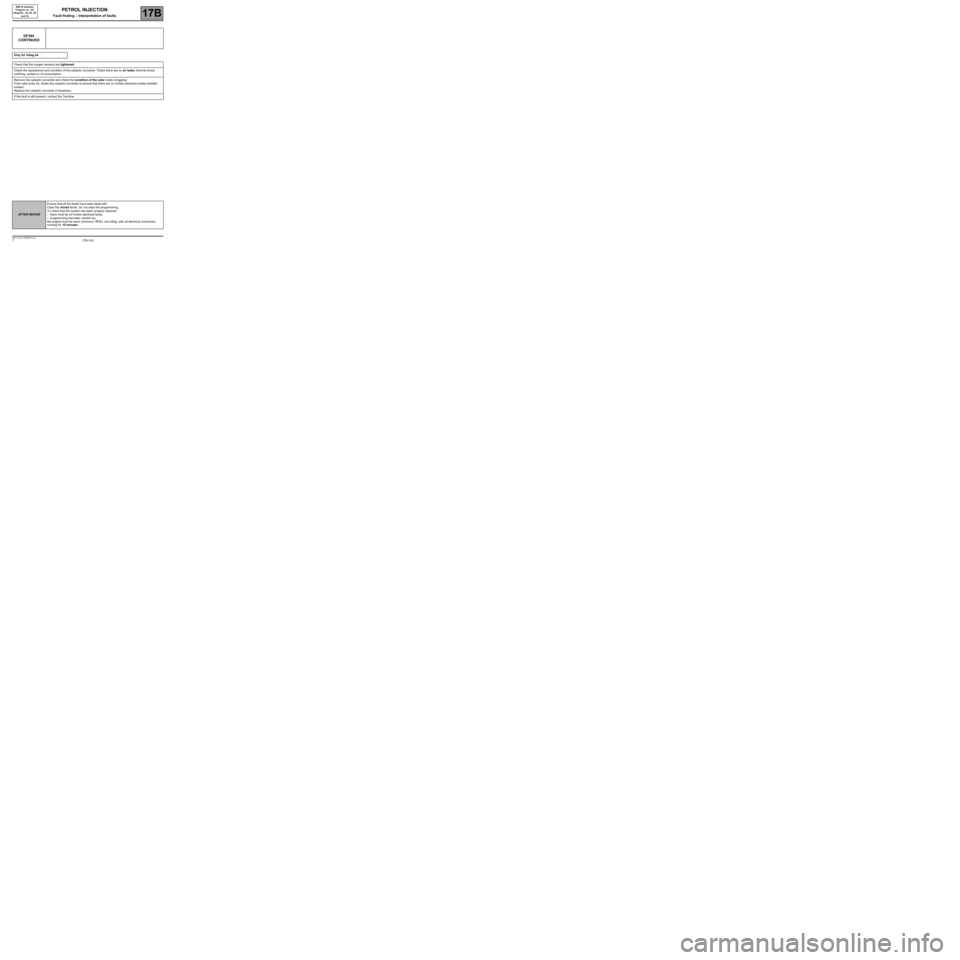
17B-143V7 MR-413-X44-17B000$133.mif
PETROL INJECTION
Fault finding – Interpretation of faults17B
SIM 32 Injection
Program no.: D3
Vdiag No.: 44, 4C, 50
and 54
DF394
CONTINUED
Only for Vdiag 44
Check that the oxygen sensors are tightened.
Check the appearance and condition of the catalytic converter. Check there are no air leaks, thermal shock,
misfiring, coolant or oil consumption.
Remove the catalytic converter and check the condition of the cake inside (clogging).
If the cake looks ok, shake the catalytic converter to ensure that there are no broken elements inside (metallic
noises).
Replace the catalytic converter if necessary.
If the fault is still present, contact the Techline.
AFTER REPAIREnsure that all the faults have been dealt with.
Clear the stored faults. Do not clear the programming.
To check that the system has been properly repaired:
–there must be no further electrical faults,
–programming has been carried out,
the engine must be warm (minimum 75˚C), and idling, with all electrical consumers
running for 15 minutes.
Page 144 of 348
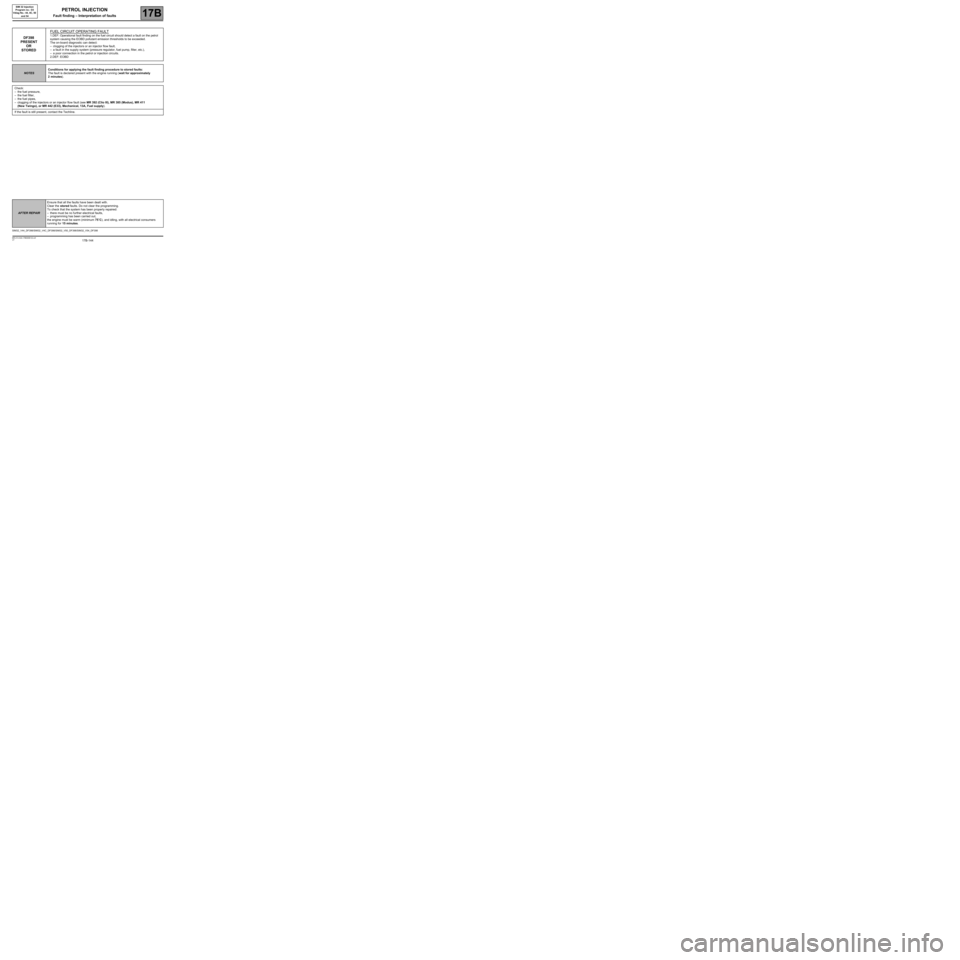
17B-144V7 MR-413-X44-17B000$133.mif
PETROL INJECTION
Fault finding – Interpretation of faults17B
SIM 32 Injection
Program no.: D3
Vdiag No.: 44, 4C, 50
and 54
DF398
PRESENT
OR
STOREDFUEL CIRCUIT OPERATING FAULT1.DEF: Operational fault finding on the fuel circuit should detect a fault on the petrol
system causing the EOBD pollutant emission thresholds to be exceeded.
The on-board diagnostic can detect:
–clogging of the injectors or an injector flow fault,
–a fault in the supply system (pressure regulator, fuel pump, filter, etc.),
–a poor connection in the petrol or injection circuits.
2.DEF: EOBD
NOTESConditions for applying the fault finding procedure to stored faults:
The fault is declared present with the engine running (wait for approximately
2 minutes).
Check:
–the fuel pressure,
–the fuel filter,
–the fuel pipes,
–clogging of the injectors or an injector flow fault (see MR 392 (Clio III), MR 385 (Modus), MR 411
(New Twingo), or MR 442 (E33), Mechanical, 13A, Fuel supply).
If the fault is still present, contact the Techline.
SIM32_V44_DF398/SIM32_V4C_DF398/SIM32_V50_DF398/SIM32_V54_DF398
AFTER REPAIREnsure that all the faults have been dealt with.
Clear the stored faults. Do not clear the programming.
To check that the system has been properly repaired:
–there must be no further electrical faults,
–programming has been carried out,
the engine must be warm (minimum 75˚C), and idling, with all electrical consumers
running for 15 minutes.
Page 145 of 348
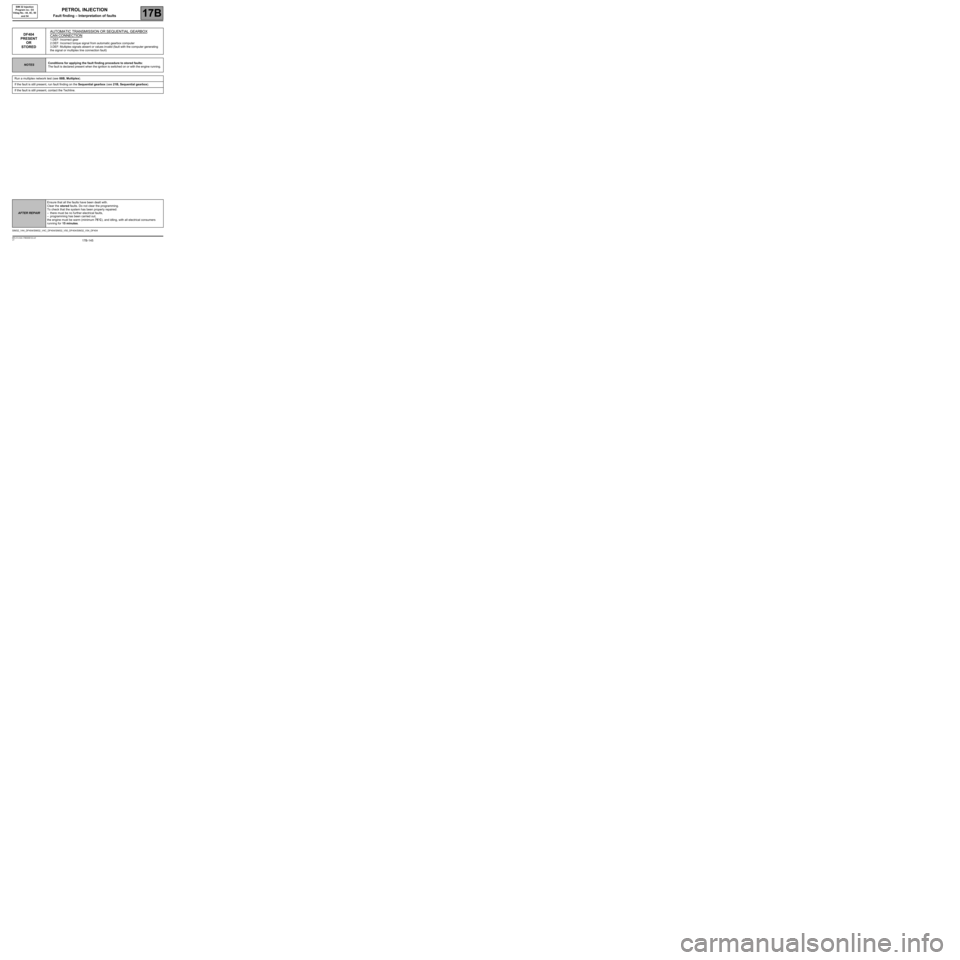
17B-145V7 MR-413-X44-17B000$133.mif
PETROL INJECTION
Fault finding – Interpretation of faults17B
SIM 32 Injection
Program no.: D3
Vdiag No.: 44, 4C, 50
and 54
DF404
PRESENT
OR
STOREDAUTOMATIC TRANSMISSION OR SEQUENTIAL GEARBOX
CAN
CONNECTION
1.DEF: Incorrect gear
2.DEF: Incorrect torque signal from automatic gearbox computer
3.DEF: Multiplex signals absent or values invalid (fault with the computer generating
the signal or multiplex line connection fault)
NOTESConditions for applying the fault finding procedure to stored faults:
The fault is declared present when the ignition is switched on or with the engine running.
Run a multiplex network test (see 88B, Multiplex).
If the fault is still present, run fault finding on the Sequential gearbox (see 21B, Sequential gearbox).
If the fault is still present, contact the Techline.
SIM32_V44_DF404/SIM32_V4C_DF404/SIM32_V50_DF404/SIM32_V54_DF404
AFTER REPAIREnsure that all the faults have been dealt with.
Clear the stored faults. Do not clear the programming.
To check that the system has been properly repaired:
–there must be no further electrical faults,
–programming has been carried out,
the engine must be warm (minimum 75˚C), and idling, with all electrical consumers
running for 15 minutes.
Page 146 of 348
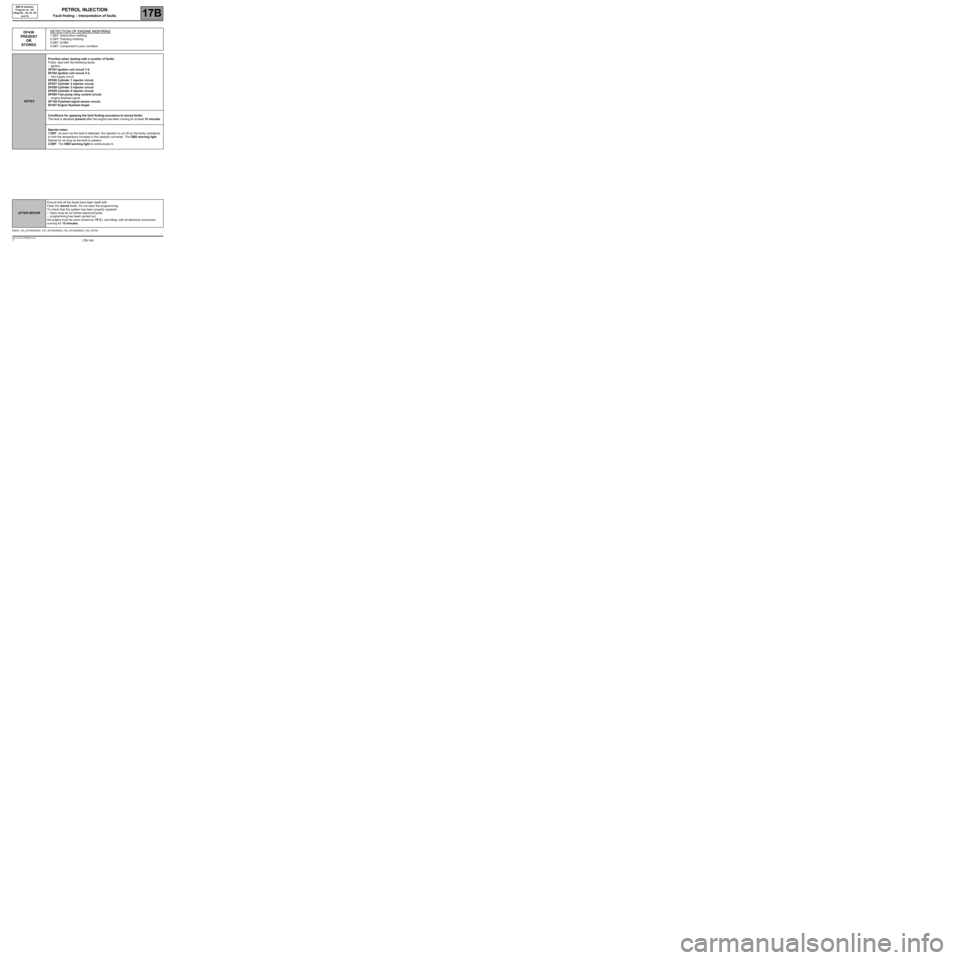
17B-146V7 MR-413-X44-17B000$133.mif
PETROL INJECTION
Fault finding – Interpretation of faults17B
SIM 32 Injection
Program no.: D3
Vdiag No.: 44, 4C, 50
and 54
DF436
PRESENT
OR
STOREDDETECTION OF ENGINE MISFIRING1.DEF: Destructive misfiring
2.DEF: Polluting misfiring
3.DEF: EOBD
4.DEF: Component in poor condition
NOTESPriorities when dealing with a number of faults:
Firstly, deal with the following faults:
–ignition
DF351 Ignition coil circuit 1-4,
DF352 Ignition coil circuit 2-3,
–fuel supply circuit
DF026 Cylinder 1 injector circuit
DF027 Cylinder 2 injector circuit,
DF028 Cylinder 3 injector circuit
DF029 Cylinder 4 injector circuit,
DF085 Fuel pump relay control circuit,
–engine flywheel signal
DF154 Flywheel signal sensor circuit,
DF457 Engine flywheel target.
Conditions for applying the fault finding procedure to stored faults:
The fault is declared present after the engine has been running for at least 15 minutes.
Special notes:
1.DEF: As soon as the fault is detected, the injection is cut off on the faulty cylinder(s)
to limit the temperature increase in the catalytic converter. The OBD warning light
flashes for as long as the fault is present.
2.DEF: The OBD warning light is continuously lit.
SIM32_V44_DF436/SIM32_V4C_DF436/SIM32_V50_DF436/SIM32_V54_DF436
AFTER REPAIREnsure that all the faults have been dealt with.
Clear the stored faults. Do not clear the programming.
To check that the system has been properly repaired:
–there must be no further electrical faults,
–programming has been carried out,
the engine must be warm (minimum 75˚C), and idling, with all electrical consumers
running for 15 minutes.
Page 147 of 348

17B-147V7 MR-413-X44-17B000$133.mif
PETROL INJECTION
Fault finding – Interpretation of faults17B
SIM 32 Injection
Program no.: D3
Vdiag No.: 44, 4C, 50
and 54
DF436
CONTINUED
If the fault is still present, carry out the following checks:
–check the flywheel signal sensor,
–check the condition and cleanliness of the flywheel,
–check the flywheel signal sensor mounting,
–check the flywheel/sensor air gap
–check the cylinder compressions,
–check the entire petrol supply system (see MR 411 (NEW TWINGO), MR 442 (E33), MR 392 (CLIO III), or
MR 385 (MODUS), Mechanical, Engine and peripherals,13A, Fuel supply),
–check the entire ignition system (see MR 411 (NEW TWINGO), MR 442 (E33), MR 392 (CLIO III), or MR 385
(MODUS), Mechanical, Engine and peripherals, 17A, Ignition, Coil and spark plugs),
–check that the correct fuel is being used,
–check that the spark plugs are correct.
If the fault is still present, contact the Techline.
AFTER REPAIREnsure that all the faults have been dealt with.
Clear the stored faults. Do not clear the programming.
To check that the system has been properly repaired:
–there must be no further electrical faults,
–programming has been carried out,
the engine must be warm (minimum 75˚C), and idling, with all electrical consumers
running for 15 minutes.
Page 149 of 348
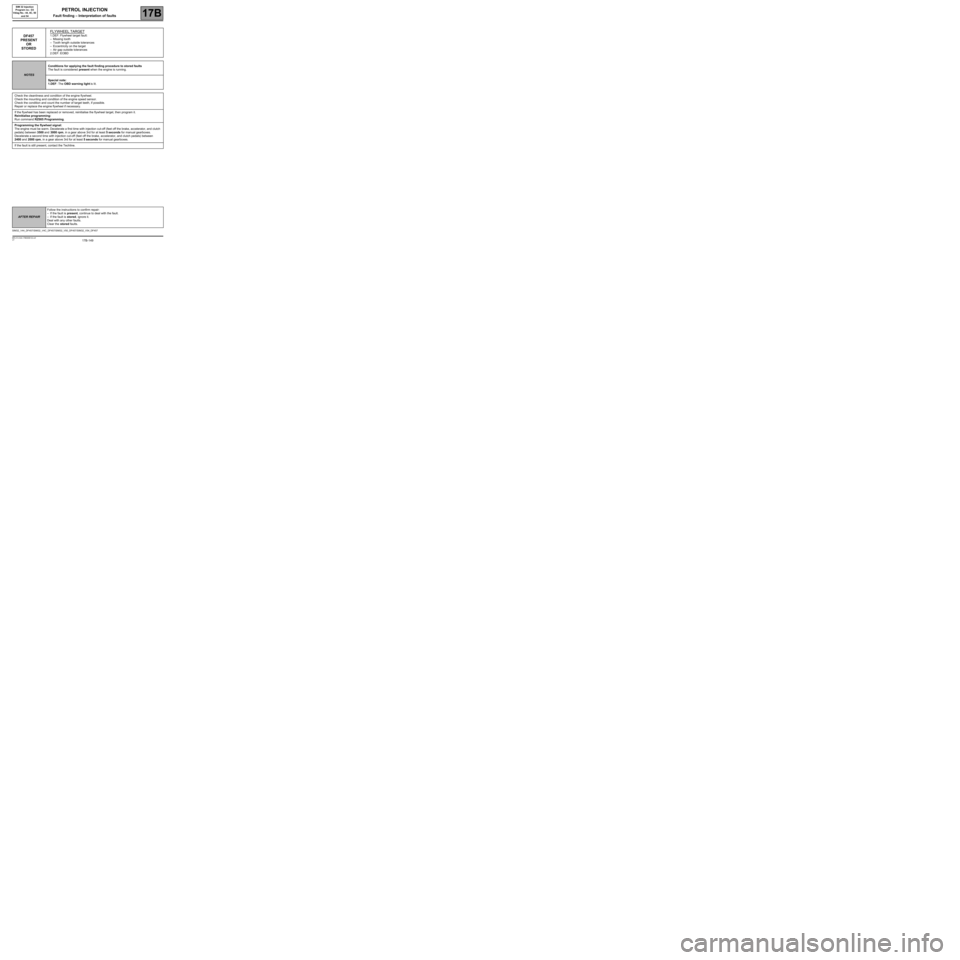
17B-149V7 MR-413-X44-17B000$133.mif
PETROL INJECTION
Fault finding – Interpretation of faults17B
SIM 32 Injection
Program no.: D3
Vdiag No.: 44, 4C, 50
and 54
DF457
PRESENT
OR
STOREDFLYWHEEL TARGET1.DEF: Flywheel target fault:
–Missing tooth
–Tooth length outside tolerances
–Eccentricity on the target
–Air gap outside tolerances
2.DEF: EOBD
NOTESConditions for applying the fault finding procedure to stored faults
The fault is considered present when the engine is running.
Special note:
1.DEF: The OBD warning light is lit.
Check the cleanliness and condition of the engine flywheel.
Check the mounting and condition of the engine speed sensor.
Check the condition and count the number of target teeth, if possible.
Repair or replace the engine flywheel if necessary.
If the flywheel has been replaced or removed, reinitialise the flywheel target, then program it.
Reinitialise programming:
Run command RZ005 Programming.
Programming the flywheel signal:
The engine must be warm. Decelerate a first time with injection cut-off (feet off the brake, accelerator, and clutch
pedals) between 3500 and 3000 rpm, in a gear above 3rd for at least 5 seconds for manual gearboxes.
Decelerate a second time with injection cut-off (feet off the brake, accelerator, and clutch pedals) between
2400 and 2000 rpm, in a gear above 3rd for at least 5 seconds for manual gearboxes.
If the fault is still present, contact the Techline.
SIM32_V44_DF457/SIM32_V4C_DF457/SIM32_V50_DF457/SIM32_V54_DF457
AFTER REPAIRFollow the instructions to confirm repair:
–If the fault is present, continue to deal with the fault.
–If the fault is stored, ignore it.
Deal with any other faults.
Clear the stored faults.
Page 150 of 348

17B-150V7 MR-413-X44-17B000$133.mif
PETROL INJECTION
Fault finding – Interpretation of faults17B
SIM 32 Injection
Program no.: D3
Vdiag No.: 44, 4C, 50
and 54
DF508
PRESENT
OR
STOREDMOTORISED THROTTLE VALVE CONTROL
1.DEF: Component in bad condition
2.DEF: EOBD
CC.1: Short circuit to 12 V
WARNING:
Never drive the vehicle without having confirmed that no faults involving the throttle valve are present.
NOTESPriorities when dealing with a number of faults:
If faults DF095 Throttle potentiometer circuit gang 1 and DF096 Throttle
potentiometer circuit gang 2 are present, deal with these first.
Conditions for applying the fault finding procedure to stored faults:
The fault is declared as present with the ignition on or the engine running, or during
command AC027 Motorised throttle.
Special notes:
In the event of faults, the level 1 warning light comes on, the injection goes into defect
mode 1 and 2, causing a limitation of vehicle and engine speed. The ESP and the cruise
control - speed limiter are deactivated.
Use the Wiring Diagrams Technical Note for NEW TWINGO, E33, CLIO III,
or MODUS.
Check the condition of the connector of the engine throttle valve (component code 120) and of the throttle valve
(component code 1076).
If the connector or connectors are faulty and if there is a repair procedure (see Technical Note 6015A, Repairing
electrical wiring, Wiring: Precautions for repair), repair the connector, otherwise replace the wiring.
SIM32_V44_DF508/SIM32_V4C_DF508/SIM32_V50_DF508/SIM32_V54_DF508
AFTER REPAIRIf the throttle valve has been replaced, program the throttle stops (see
Configurations and programming).
Follow the instructions to confirm repair:
–If the fault is present, continue to deal with the fault.
–If the fault is stored, ignore it.
Deal with any other faults.
Clear the stored faults.
Page 152 of 348
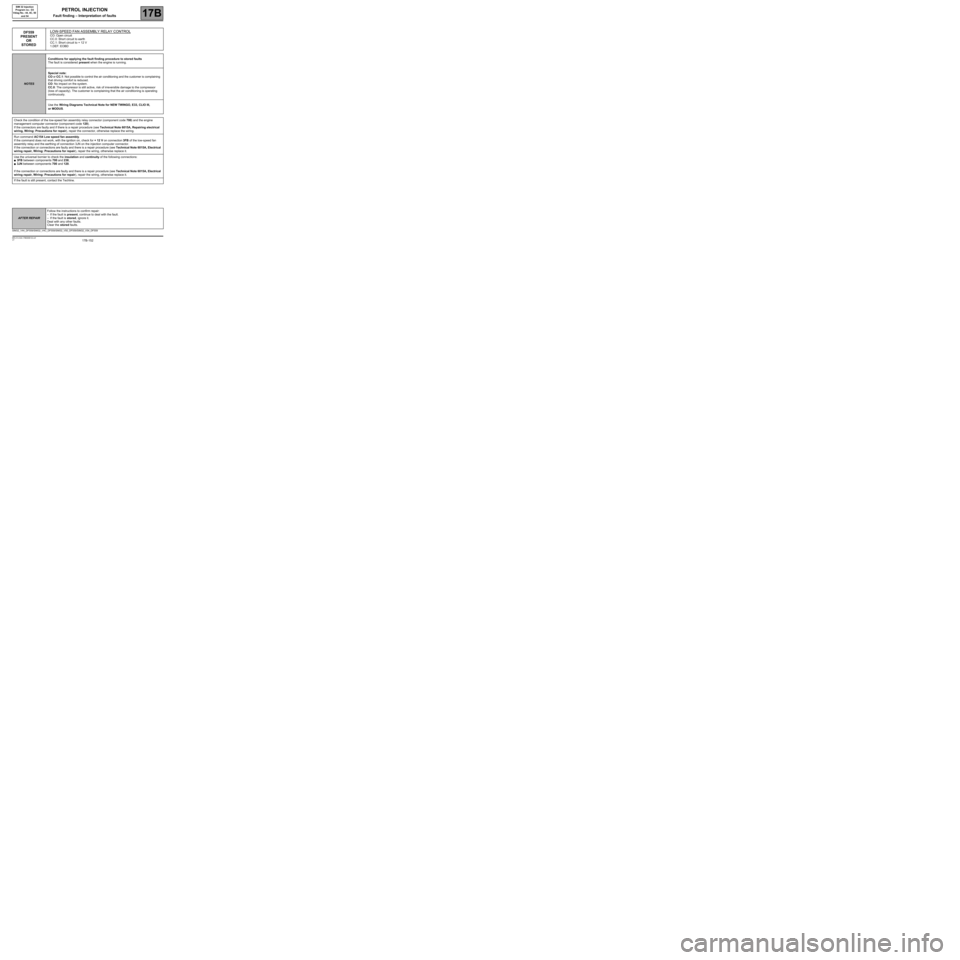
17B-152V7 MR-413-X44-17B000$133.mif
PETROL INJECTION
Fault finding – Interpretation of faults17B
SIM 32 Injection
Program no.: D3
Vdiag No.: 44, 4C, 50
and 54
DF559
PRESENT
OR
STOREDLOW-SPEED FAN ASSEMBLY RELAY CONTROLCO: Open circuit
CC.0: Short circuit to earth
CC.1: Short circuit to + 12 V
1.DEF: EOBD
NOTESConditions for applying the fault finding procedure to stored faults
The fault is considered present when the engine is running.
Special note:
CO or CC.1: Not possible to control the air conditioning and the customer is complaining
that driving comfort is reduced.
CO: No impact on the system.
CC.0: The compressor is still active, risk of irreversible damage to the compressor
(loss of capacity). The customer is complaining that the air conditioning is operating
continuously.
Use the Wiring Diagrams Technical Note for NEW TWINGO, E33, CLIO III,
or MODUS.
Check the condition of the low-speed fan assembly relay connector (component code 700) and the engine
management computer connector (component code 120).
If the connectors are faulty and if there is a repair procedure (see Technical Note 6015A, Repairing electrical
wiring, Wiring: Precautions for repair), repair the connector, otherwise replace the wiring.
Run command AC154 Low speed fan assembly.
If the command does not work, with the ignition on, check for + 12 V on connection 3FB of the low-speed fan
assembly relay and the earthing of connection 3JN on the injection computer connector.
If the connection or connections are faulty and there is a repair procedure (see Technical Note 6015A, Electrical
wiring repair, Wiring: Precautions for repair), repair the wiring, otherwise replace it.
Use the universal bornier to check the insulation and continuity of the following connections:
●3FB between components 700 and 238,
●3JN between components 700 and 120.
If the connection or connections are faulty and there is a repair procedure (see Technical Note 6015A, Electrical
wiring repair, Wiring: Precautions for repair), repair the wiring, otherwise replace it.
If the fault is still present, contact the Techline.
SIM32_V44_DF559/SIM32_V4C_DF559/SIM32_V50_DF559/SIM32_V54_DF559
AFTER REPAIRFollow the instructions to confirm repair:
–If the fault is present, continue to deal with the fault.
–If the fault is stored, ignore it.
Deal with any other faults.
Clear the stored faults.
Page 153 of 348
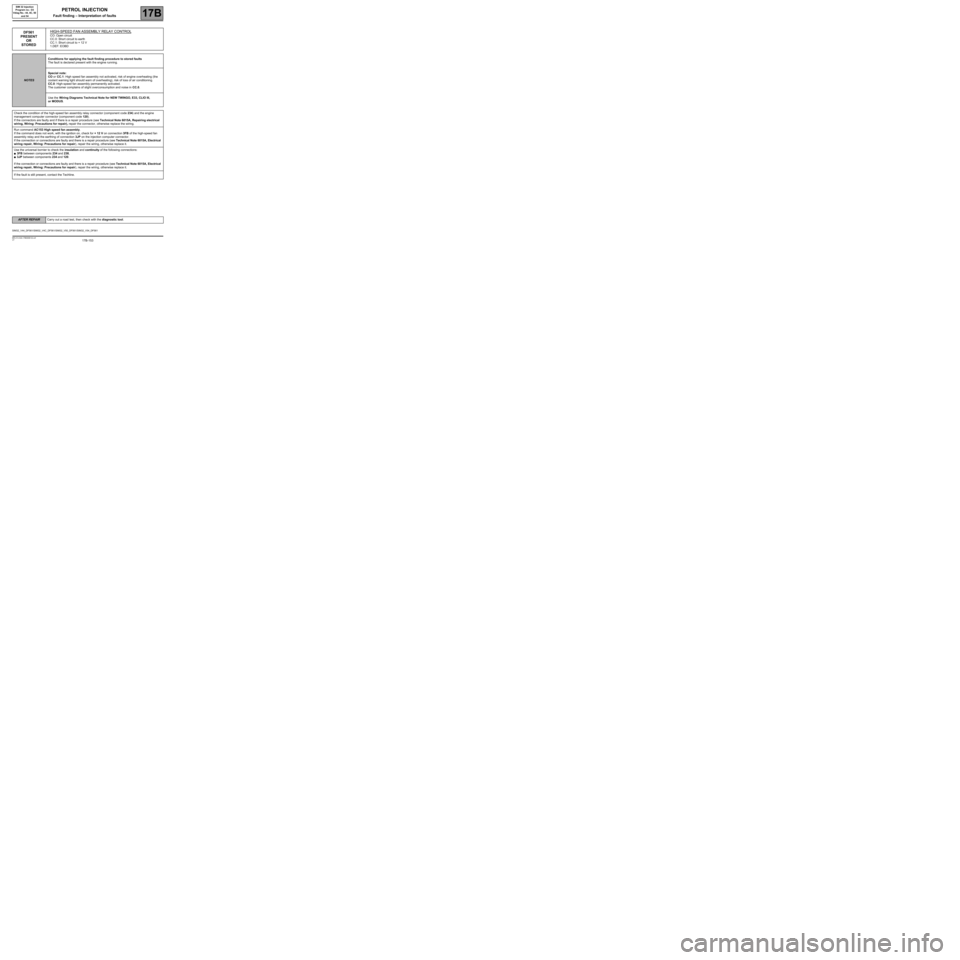
17B-153V7 MR-413-X44-17B000$133.mif
PETROL INJECTION
Fault finding – Interpretation of faults17B
SIM 32 Injection
Program no.: D3
Vdiag No.: 44, 4C, 50
and 54
DF561
PRESENT
OR
STOREDHIGH-SPEED FAN ASSEMBLY RELAY CONTROLCO: Open circuit
CC.0: Short circuit to earth
CC.1: Short circuit to + 12 V
1.DEF: EOBD
NOTESConditions for applying the fault finding procedure to stored faults
The fault is declared present with the engine running.
Special note:
CO or CC.1: High speed fan assembly not activated, risk of engine overheating (the
coolant warning light should warn of overheating), risk of loss of air conditioning.
CC.0: High-speed fan assembly permanently activated.
The customer complains of slight overconsumption and noise in CC.0.
Use the Wiring Diagrams Technical Note for NEW TWINGO, E33, CLIO III,
or MODUS.
Check the condition of the high-speed fan assembly relay connector (component code 234) and the engine
management computer connector (component code 120).
If the connectors are faulty and if there is a repair procedure (see Technical Note 6015A, Repairing electrical
wiring, Wiring: Precautions for repair), repair the connector, otherwise replace the wiring.
Run command AC153 High speed fan assembly.
If the command does not work, with the ignition on, check for + 12 V on connection 3FB of the high-speed fan
assembly relay and the earthing of connection 3JP on the injection computer connector.
If the connection or connections are faulty and there is a repair procedure (see Technical Note 6015A, Electrical
wiring repair, Wiring: Precautions for repair), repair the wiring, otherwise replace it.
Use the universal bornier to check the insulation and continuity of the following connections:
●3FB between components 234 and 238,
●3JP between components 234 and 120.
If the connection or connections are faulty and there is a repair procedure (see Technical Note 6015A, Electrical
wiring repair, Wiring: Precautions for repair), repair the wiring, otherwise replace it.
If the fault is still present, contact the Techline.
SIM32_V44_DF561/SIM32_V4C_DF561/SIM32_V50_DF561/SIM32_V54_DF561
AFTER REPAIRCarry out a road test, then check with the diagnostic tool.